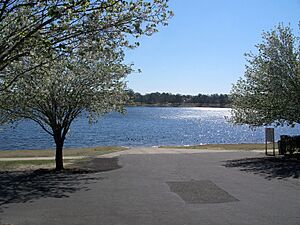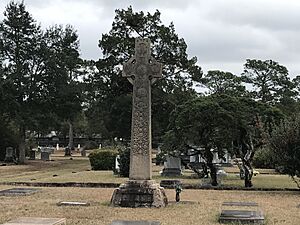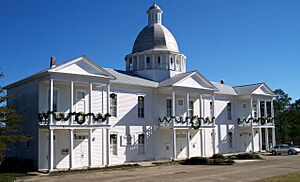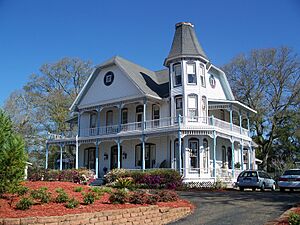DeFuniak Springs, Florida facts for kids
Quick facts for kids
DeFuniak Springs, Florida
|
|
|---|---|
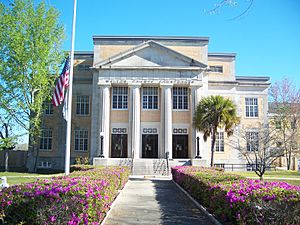
Walton County Courthouse
|
|
| Motto(s):
"Partnership, Planning, And Preservation"
|
|
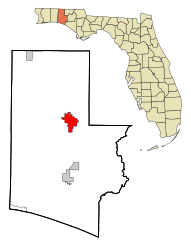
Location in Walton County and the state of Florida
|
|
| Country | United States of America |
| State | Florida |
| County | Walton |
| Incorporated | 1901 |
| Government | |
| • Type | Council–Manager |
| Area | |
| • Total | 14.30 sq mi (37.03 km2) |
| • Land | 13.95 sq mi (36.13 km2) |
| • Water | 0.35 sq mi (0.90 km2) |
| Elevation | 259 ft (79 m) |
| Population
(2020)
|
|
| • Total | 5,919 |
| • Density | 424.30/sq mi (163.82/km2) |
| Time zone | UTC-6 (Central (CST)) |
| • Summer (DST) | UTC-5 (CDT) |
| ZIP codes |
32433, 32435
|
| Area code(s) | 850 |
| FIPS code | 12-16800 |
| GNIS feature ID | 0294592 |
| Website | http://www.defuniaksprings.net |
DeFuniak Springs is a city in Walton County, Florida, United States. It's the main city of the county. In 2020, about 5,919 people lived there. This city is part of a larger area that includes Crestview, Fort Walton Beach, and Destin, Florida.
DeFuniak Springs is special because it's home to Lake DeFuniak. This lake is one of only two lakes in the world that are almost perfectly round and fed by natural springs.
Contents
History of DeFuniak Springs
The city of DeFuniak Springs was started in the late 1800s. It was created as a vacation spot by leaders of the Pensacola and Atlantic Railroad. This railroad connected different parts of Florida. The city was named after Frederick R. De Funiak, who was a vice-president of the railroad. Many of the early settlers in this area came from Scotland, through places like Virginia and the Carolinas.
DeFuniak Springs was designed to be a final stop for tourists. The city worked with the Chautauqua Movement, which was a popular adult education movement. They built a large building called the Chautauqua Hall of Brotherhood right on Lake DeFuniak. This hall could hold 4,000 people. Here, people on vacation could attend classes and learn new things.
Sadly, a big storm called Hurricane Eloise badly damaged the auditorium part of the Hall of Brotherhood in 1975, and it had to be taken down. However, a group called the Chautauqua Hall of Brotherhood Foundation started a project in 2003 to restore the historic building.
To support the city's focus on learning, several schools were built in the late 1800s. These included Palmer College and Palmer Academy. There was also a technical school and a teacher training school called Florida Normal College. Florida Normal College later became part of Florida State University. The other schools closed during the Great Depression because of money problems. You can still find a street named College Avenue in the city, which once led to Palmer College.
In 1886, an important meeting happened in DeFuniak Springs. Teachers from all over Florida came together to form the Florida Education Association. This group is still the main voice for educators in Florida today.
Geography and Location
DeFuniak Springs is located in the Florida Panhandle. You can reach it by major roads like Interstate 10 and U.S. Routes 90 and 331. Interstate 10 runs south of the city. It connects DeFuniak Springs to Tallahassee (about 119 kilometers east) and Pensacola (about 80 kilometers west).
U.S. Route 90 goes through the city as Nelson Avenue. It leads east to Ponce de Leon and west to Crestview. U.S. Route 331 is a main road that goes north and south through the city. It connects DeFuniak Springs to Florala, Alabama to the northwest, and to the Gulf coast near Santa Rosa Beach to the south.
The city covers a total area of about 37.03 square kilometers (14.30 square miles). Most of this area is land, with a small part being water.
Neighborhoods in DeFuniak Springs
DeFuniak Springs has several interesting neighborhoods:
- Historic District: This is the heart of the city. It has the 260-acre Chipley Park and Lake DeFuniak. The Historic Downtown District here has shops, restaurants, and bakeries.
- Freeport: This area is known for its natural beauty, seafood, and local culture.
- Paxton: This is a friendly community with a history of farming. It has lakes for kayaking and is home to Britton Hill, which is the highest point in Florida.
- Mossy Head and Sawmill Court are newer communities in DeFuniak Springs.
Magnolia Cemetery is also located in the northeast part of the city.
Climate
DeFuniak Springs has a humid subtropical climate. This means it gets a lot of rain, especially in the summer. It can also be affected by tropical storms and hurricanes because it is close to the Gulf Coast.
| Climate data for DeFuniak Springs 1 E, Florida, 1991–2020 normals, extremes 1896–2010 | |||||||||||||
|---|---|---|---|---|---|---|---|---|---|---|---|---|---|
| Month | Jan | Feb | Mar | Apr | May | Jun | Jul | Aug | Sep | Oct | Nov | Dec | Year |
| Record high °F (°C) | 84 (29) |
86 (30) |
91 (33) |
97 (36) |
102 (39) |
107 (42) |
105 (41) |
104 (40) |
104 (40) |
98 (37) |
92 (33) |
89 (32) |
107 (42) |
| Mean daily maximum °F (°C) | 62.3 (16.8) |
65.8 (18.8) |
72.7 (22.6) |
79.2 (26.2) |
86.4 (30.2) |
90.3 (32.4) |
92.3 (33.5) |
91.4 (33.0) |
88.3 (31.3) |
80.5 (26.9) |
71.3 (21.8) |
64.3 (17.9) |
78.7 (25.9) |
| Daily mean °F (°C) | 50.9 (10.5) |
54.6 (12.6) |
60.4 (15.8) |
66.6 (19.2) |
74.8 (23.8) |
80.3 (26.8) |
82.4 (28.0) |
81.5 (27.5) |
77.8 (25.4) |
68.9 (20.5) |
58.9 (14.9) |
53.1 (11.7) |
67.5 (19.7) |
| Mean daily minimum °F (°C) | 39.5 (4.2) |
43.4 (6.3) |
48.0 (8.9) |
54.0 (12.2) |
63.1 (17.3) |
70.2 (21.2) |
72.4 (22.4) |
71.7 (22.1) |
67.4 (19.7) |
57.4 (14.1) |
46.6 (8.1) |
41.8 (5.4) |
56.3 (13.5) |
| Record low °F (°C) | 3 (−16) |
0 (−18) |
19 (−7) |
21 (−6) |
35 (2) |
43 (6) |
54 (12) |
55 (13) |
35 (2) |
28 (−2) |
16 (−9) |
5 (−15) |
0 (−18) |
| Average precipitation inches (mm) | 5.04 (128) |
5.07 (129) |
5.18 (132) |
4.30 (109) |
3.99 (101) |
7.10 (180) |
7.50 (191) |
6.95 (177) |
6.04 (153) |
3.58 (91) |
4.43 (113) |
5.45 (138) |
64.63 (1,642) |
| Average precipitation days (≥ 0.01 in) | 9.2 | 8.3 | 8.0 | 7.0 | 7.6 | 12.7 | 14.2 | 13.9 | 10.3 | 6.2 | 7.0 | 8.6 | 113.0 |
| Source: NOAA | |||||||||||||
Population Information
| Historical population | |||
|---|---|---|---|
| Census | Pop. | %± | |
| 1890 | 672 | — | |
| 1910 | 2,017 | — | |
| 1920 | 2,097 | 4.0% | |
| 1930 | 2,636 | 25.7% | |
| 1940 | 2,570 | −2.5% | |
| 1950 | 3,077 | 19.7% | |
| 1960 | 5,282 | 71.7% | |
| 1970 | 4,966 | −6.0% | |
| 1980 | 5,563 | 12.0% | |
| 1990 | 5,120 | −8.0% | |
| 2000 | 5,089 | −0.6% | |
| 2010 | 5,177 | 1.7% | |
| 2020 | 5,919 | 14.3% | |
| U.S. Decennial Census | |||
Population Changes (2010 and 2020)
| Race | Pop 2010 | Pop 2020 | % 2010 | % 2020 |
|---|---|---|---|---|
| White (NH) | 3,555 | 3,753 | 68.67% | 63.41% |
| Black or African American (NH) | 1,045 | 996 | 20.19% | 16.83% |
| Native American or Alaska Native (NH) | 34 | 26 | 0.66% | 0.44% |
| Asian (NH) | 33 | 54 | 0.64% | 0.91% |
| Pacific Islander or Native Hawaiian (NH) | 3 | 2 | 0.06% | 0.03% |
| Some other race (NH) | 7 | 40 | 0.14% | 0.68% |
| Two or more races/Multiracial (NH) | 113 | 393 | 2.18% | 6.64% |
| Hispanic or Latino (any race) | 387 | 655 | 7.48% | 11.07% |
| Total | 5,177 | 5,919 |
In 2020, the city had 5,919 people living there. There were 2,848 households and 1,789 families. In 2010, there were 5,177 people and 2,306 households.
Arts and Culture
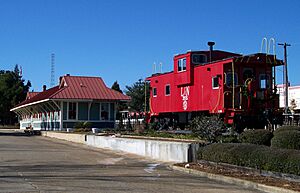
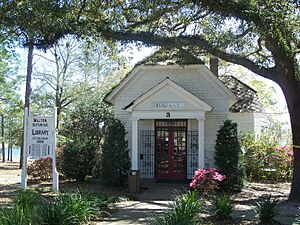
Local Traditions
Around the holidays, from Thanksgiving to New Year's Day, the area around Lake DeFuniak is decorated with lights. Locals call this event "Christmas Reflections."
Historic Places to Visit
DeFuniak Springs has many historic sites:
- Walton-DeFuniak Library: This is the oldest library still standing in Florida.
- Walton County Heritage Museum: This museum is located in the old Louisville and Nashville Railroad train station.
- St. Agatha's Episcopal Church: This church was built between 1895 and 1896.
- First Presbyterian Church.
- The first Confederate Monument in Florida: This monument is on the lawn of the Walton County Courthouse.
The Community Library
When DeFuniak Springs was being planned, its founders were very interested in adult education. This included the Chautauqua center, universities, and also a community library.
In 1887, a group of women formed the Ladies Library Association. Their goal was to create a library that would work with the other learning centers. They chose a spot next to the Chautauqua center. By the end of 1887, just five years after the city was planned, the community library was open.
At first, the library relied on donated books. The Ladies Library Association worked hard to keep the library running. By 1923, they needed help, so the city started to provide funds. In the 1960s, people no longer had to pay to use the library. The city and county then took full responsibility for it. Today, the Walton-DeFuniak Library has old artifacts, a collection of medieval weapons, and many first-edition books.
Education in DeFuniak Springs
Public Schools
Public schools in DeFuniak Springs are managed by the Walton County School District.
- Walton High School
- Walton Middle School
- Maude Saunders Elementary School
- Mossy Head Elementary School
- West DeFuniak Elementary School
- Walton Academy
Private Schools
- First Christian Academy
Famous People from DeFuniak Springs
- Buck Showalter (born 1956): A professional baseball manager.
- Kyrsten Sinema (born 1976): A politician who serves as a United States senator for Arizona.
- Jerry Shriver: A soldier in the U.S. Army Special Forces.
- Wankard Pooser: A Florida politician.
See also
 In Spanish: DeFuniak Springs para niños
In Spanish: DeFuniak Springs para niños


